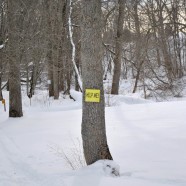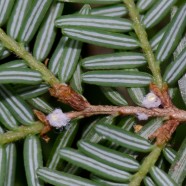Need Some Info?
Scattered around the county snowmobile and multipurpose trails are these info shacks, some of which have our “Nature at Your Fingertips” winter trails cell phone tour signs attached to them. This weekend while you are enjoying the expansive network of trails Chautauqua County has to offer, take a moment to look for these little blue signs as they will provide some fascinating information about our area! Elyse Henshaw Conservation Technician
Read MoreForest Pest Project Continues
As National Invasive Species Awareness Week (NISAW) continues, we are continuing to work on our Collaborative Forest Pest Outreach Project in partnership with Cornell Cooperative Extension of Chautauqua County. Today we erected Help Me! signs on Ash trees in a park in Kennedy, New York, an active fishing area and trail-head for the snowmobile trails. Through this project we hope to reach those that visit the park, and other areas where these signs are posted, educating about forest pests such as Hemlock Woolly Adelgid and Emerald Ash Borer in a fun and empowering way.
Read MoreKick Off For NISAW
Happy National Invasive Species Awareness Week (NISAW)! As events are taking place around the country, spreading the word about invasive species, we teamed up with our friend Andrea Locke WNY PRISM Coordinator to kick things off with a training session on Asian Long-horned Beetle (ALB), Emerald Ash Borer (EAB) and Hemlock Woolly Adelgid (HWA). We had 16 people in attendance of the training session and had a brave few stay for the outdoor survey portion of the training, bearing the cold temperatures while searching for HWA here at RTPI. We are happy to report that we didn’t find any in...
Read MoreHWA Here to Stay?
It’s official friends, HWA has been found in Chautauqua County. Over the holidays, Hemlock Woolly Adelgid (HWA) was encountered on a number of Eastern Hemlock trees (Tsuga canadensis) near Fredonia. These trees exhibited the signs and symptoms of the invasive insect’s presence, having twigs covered in white woolly masses and dying needles, discolored due to loss of nutrients. Due to its small size and discrete nature, HWA can easily go undetected until it is too late, and death of the attacked hemlock is inevitable. However, it CAN be stopped and we CAN help the hemlocks...
Read More







